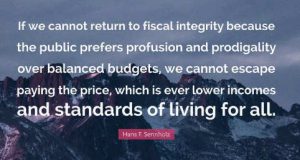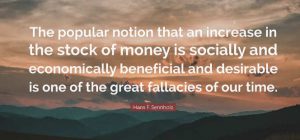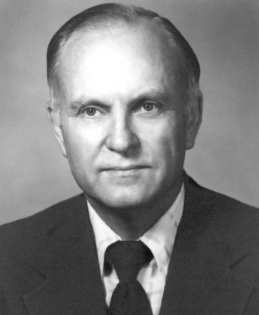I grew up reading the works of Hans Sennholz, one of the leading thinkers of the Austrian Economics movement. The following article although originally published in 2005 is as timely now as it was then. He was the author and co-author of many books including Money and Freedom, Gold, Freedom, and Free Markets, The Politics of Unemployment, and Man Must Work (an idea that is certainly out of fashion now). Many of his works are out of print and difficult to locate now like Age of Inflation and Debts and Deficits.
In 1972, the Congressional Record recorded his wild projection of the federal debt reaching $4 trillion by 1993, when the federal debt was less than $450 billion. The actual figure turned out to be $4.411 trillion! An amazingly accurate projection for 20 years into the future! Well known for his stock market analyses, Dr. Sennholz also anticipated early in 1987 the 500-point crash of October 19, 1987. This article was originally written in 2005 so the value compared to a 1970 dollar is much less now than it was then. ~Tim McMahon, editor.
The Many Evils of Inflation
Many people know how to earn money, but few are aware of what the Federal Reserve System, acting on behalf of the U.S. Government, is doing to their money. It is inflating and depreciating the dollar at various rates—at double-digit rates during the 1970s and early 80s and at single-digit rates ever since. The present dollar is worth no more than 10 cents of the 1970 dollar and 50 cents of the 1980 dollar.
The reasons and explanations given for this loss may change over time, but the consequences are always the same. Inflation covertly transfers income and wealth from all creditors to all debtors. It dispossessed present creditors of nine-tenths of their 1980 savings and enriched debtors by the same amount. The dollar savings accumulated since then have shrunk at lesser rates but are fading away notwithstanding.
No wonder, many victims readily conclude that thrift and self-reliance are useless and even injurious and that spending and debt are preferable by far. They may join the multitudes of spenders who prefer to consume today and pay tomorrow, and they may call on the government demanding compensation, aid, and care in many forms. Surely, the hurt and harm inflicted by inflation are a mighty driving force for government programs and benefits.
In their discussions and analyses of various problems, economists usually avoid the use of moral terms dealing with ultimate principles that should govern human conduct. Ever fearful of being embroiled in ethical controversies they seek to remain neutral and “value-free.” They do counsel legislators and regulators on the cost-efficiency of a policy but not on its moral implications. They may offer professional advice on the efficiency of money management but not on the morality or immorality of inflationary policies. They dare not state that inflation is a pernicious form of taxation which most people do not recognize as such.
Authorities of money and banking rather than taxing authorities redistribute income and wealth under cover of ignorance. Placed on every person in the form of higher goods prices, the application does not fall equally and simultaneously on every buyer. The people who receive the newly created money first may actually benefit as goods prices readjust rather slowly. Others who receive it later or not at all will have to tighten their belts. Above all, inflation ravishes the savings of countless Americans and turns many into prodigal spenders and debtors.
The biggest debtor also is the biggest inflation profiteer. With some eight trillion dollars in debt, the Federal Government is by far the biggest winner. In fact, it gains not only from debt depreciation, which at just three percent amounts to some $240 billion every year, but also from Federal Reserve money and credit creation that enables the U.S. Treasury to suffer annual budget deficits of some $500 billion a year.
Without the power to in flate and depreciate the dollar at will, the U.S. Government would be a different institution, like that which the Founding Fathers had envisioned. But endowed with the power of inflation it has become an almighty organization that redistributes income and wealth and refashions the social and economic order.
flate and depreciate the dollar at will, the U.S. Government would be a different institution, like that which the Founding Fathers had envisioned. But endowed with the power of inflation it has become an almighty organization that redistributes income and wealth and refashions the social and economic order.
The primary beneficiaries of the new order are its own managers: legislators, regulators, and a huge army of civil servants. They are first in power, prestige, and benefits. Many U.S. Senators and Congressmen are the admired and esteemed benefactors of countless petitioners for handouts and favors. They are revered for every benefit they bestow. And there are the officials of the Department of Commerce with 7 benefit programs, the Department of Education with 34 programs, the Department of Energy with 6, the Department of Health and Human Services with 8, the Department of Housing and Urban Development with 14, the Department of the Interior with 3, the Department of Labor with 9, the Department of Transportation with 9, and various government commissions and authorities with another 10 programs.
Federal politicians and agents are the wise and virtuous judges and juries of benefits amounting to more than $1 trillion every year. How “honorable” would they be, pray tell, without Federal Reserve assistance in financing the deficits and its power to print more money?
Evil acts tend to breed more evil acts. Inflationary policies conducted for long periods of time not only foster the growth of government but also depress economic activity. Standards of living may stagnate or even decline as growing budget deficits thwart capital accumulation and investment that are sustaining the standards.
 Inflation misleads businessmen in their investment decisions, which causes much waste and many bankruptcies. In fact, it is the root cause of the boom-and-bust cycle which wreaks havoc on economic activity. Indeed, inflation breeds many evils of which most Americans are unaware.
Inflation misleads businessmen in their investment decisions, which causes much waste and many bankruptcies. In fact, it is the root cause of the boom-and-bust cycle which wreaks havoc on economic activity. Indeed, inflation breeds many evils of which most Americans are unaware.
Since 1971 when President Nixon abolished the last vestiges of the gold standard and repudiated all obligations to meet international obligations with payments in gold, the U.S. dollar has been the dominant world currency. It enables Americans to buy massive quantities of foreign goods and services, suffering annual trade deficits of more than half a trillion dollars now, and making payments in ever depreciating dollars. Foreign central and commercial banks as well as many foreign individuals are using their dollars with the hope that they will retain their purchasing power in the long run. Asian creditors are holding more than $2 trillion in claims, and Japan and China alone an estimated $1.5 trillion between them.
A dollar depreciation rate of just 3 percent strips Japan and China of some $45 billion in purchasing power every year. They undoubtedly are suffering such losses in silence because they are mindful of the many benefits they are receiving from amicable relations with the United States. American capital is rushing into China, building many plants and introducing modern technology while some 20,000 young Chinese are studying at American colleges and universities.
At the same time, Japanese and Chinese companies are investing surplus dollars in the United States, assuming control over American corporations. If the United States government should ever disrupt this peaceful relationship with discriminatory trade restrictions and painful barriers, the Asian creditors may dump some dollar holdings. The dollar crash would be heard around the globe.
There is no conscience in politics. Economic policies may be changed, reformed, and readjusted because they are ineffective, unproductive, and unpopular, but rarely ever because they are immoral. Debt may be a grievous bondage to an honorable man, but it may be a “national bond” which, in President Roosevelt’s words, “is owed not only by the nation but also to the nation.” Surely, politicians have a code of laws to observe and obey, but honesty in matters of debt and money is not one of them.
If it is true that we cannot do wrong without suffering wrong, we must brace for more grief to come.
Hans F. Sennholz (1922-2007) was Ludwig von Mises’s first PhD student in the United States. He taught economics at Grove City College, 1956–1992, having been hired as department chair upon arrival. After he retired, he became president of the Foundation for Economic Education, where he served from 1992-1997. He was an adjunct scholar of the Mises Institute, and in October 2004 was awarded the Gary G. Schlarbaum Prize for lifetime defense of liberty.
Sennholz’s contributions to the rebirth of interest in Austrian monetary and business cycle theory demonstrate the continuing importance of his works today. Along with Mises and Rothbard, Sennholz was one of a handful of academic economists to stand fast against the postwar tidal waves of Keynesian macroeconomics and Friedmanite monetarism that swept over American academia in the 1950s and 1960s and threatened to completely submerge sound monetary economics.




This article shows that nothing has been learned from the 70’s rampant inflation. Sennholz would be shocked by the numbers today. What is one to do when their enemy is their government?